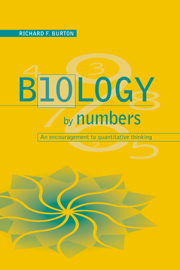Book contents
- Frontmatter
- Contents
- Preface
- A guide to the book
- 1 Putting two and two together
- 2 Units, formulae and the use of old envelopes: confronting some obstacles to quantitative thinking
- 3 Aspects of energy metabolism
- 4 Getting things in proportion
- 5 Perilous percentages, dangerous ratios
- 6 Building a trophic pyramid
- 7 Sodium in animals and plants
- 8 Exchanges of water and carbon dioxide
- 9 A geometric series
- 10 Introduction to logarithms
- 11 Bringing logarithms to life
- 12 Exponential relationships
- 13 Aspects of allometry
- 14 More on allometry, and on quantitative patterns in nature
- 15 How the abundance of food affects rates of feeding
- 16 The characterization of trees and other branching systems
- 17 Epilogue
- References
- Notes
- Index
7 - Sodium in animals and plants
Published online by Cambridge University Press: 05 June 2012
- Frontmatter
- Contents
- Preface
- A guide to the book
- 1 Putting two and two together
- 2 Units, formulae and the use of old envelopes: confronting some obstacles to quantitative thinking
- 3 Aspects of energy metabolism
- 4 Getting things in proportion
- 5 Perilous percentages, dangerous ratios
- 6 Building a trophic pyramid
- 7 Sodium in animals and plants
- 8 Exchanges of water and carbon dioxide
- 9 A geometric series
- 10 Introduction to logarithms
- 11 Bringing logarithms to life
- 12 Exponential relationships
- 13 Aspects of allometry
- 14 More on allometry, and on quantitative patterns in nature
- 15 How the abundance of food affects rates of feeding
- 16 The characterization of trees and other branching systems
- 17 Epilogue
- References
- Notes
- Index
Summary
Multicellular animals and terrestrial plants tend to differ markedly in sodium content and this can be important in relation to animal diet. Cells in general do not contain much sodium, while the extracellular fluid bathing them in most multicellular animals contains a great deal. Indeed, the sodium content of this extracellular fluid is usually more like that of sea water in the case of marine invertebrates, or about one-third of that in the case of vertebrates and many non-marine invertebrates. Multicellular plants do not have the equivalent kind of extracellular fluid and, while some have a high sodium content (notably some growing near the sea), others contain hardly any. The low sodium content of some plant material can have profound implications for herbivorous animals and these are explored here in relation to insects and one particular mammal, the moose. The distribution of sodium within our own bodies is also looked at briefly in Section 7.4.
Sodium in herbivorous insects
Potato leaves and tubers contain about 0.5–2.4 mg of sodium per kilogram fresh mass (Steward, Moreno & Roca, 1981). The equivalent figure for the human body is about 1300 mg/kg.
Think of an insect feeding entirely on potato leaves, a hypothetical insect that contains, when fully grown, about the same concentration of sodium as we do. (Once again I am utilizing data for the human body because they are so readily available.) The leaves contain, say, 1.3 mg/kg, a representative figure within the above range that is chosen for easy arithmetic.
- Type
- Chapter
- Information
- Biology by NumbersAn Encouragement to Quantitative Thinking, pp. 81 - 86Publisher: Cambridge University PressPrint publication year: 1998



